PST to Office 365 Migration
Step 1: Open the Kernel Email Migrator software and click on the Outlook PST Files button under the Source section.

Step 2: Select the migration type - PST to Office 365. Give project name and a job name. Then click Next. This job will be the part of the project name you have given.
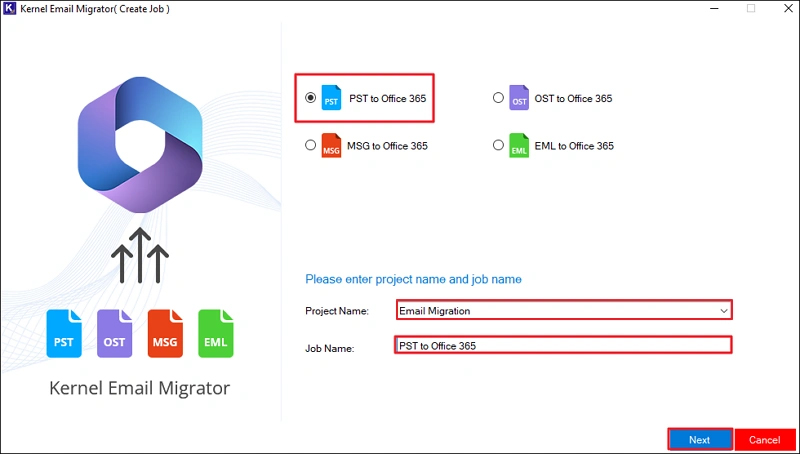
Step 3: Now, we will select the PST file(s) that you want to migrate to Office 365. Click on the Add button under the Step 1: Add Source section.

Step 4: Go to the location where the PST file(s) are available. Select single or multiple files and click Open to add these files as the source.
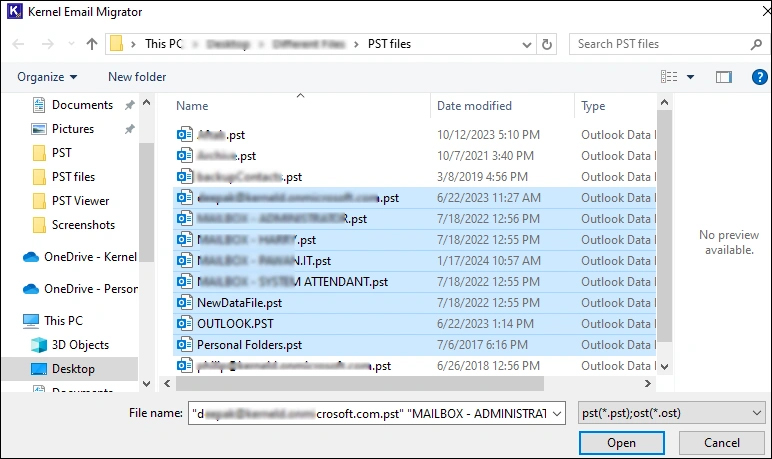
Step 5: After adding the source PST files, let's configure the destination Office 365 account. Click Add button in the Step 2: Add Destination section.

Step 6: Under the Connect Destination, provide Tenant ID, Client ID, and Client Secret Value for the Microsoft 365 account you wish to add as the destination. After entering the credentials, click Connect to authenticate the values and establish a secure connection between the email migrator and the Office 365 account.

Step 7: To migrate the PST files to a single mailbox, select Single Mailbox User. However, to transfer different PST files to different mailboxes, select the List All Mailbox Using Above Credentials option and click on the Get User Mailbox button. Then, select the mailboxes from the list and click Add.

Step 8: For accurate email migration, you must map the source PST file to a destination user mailbox. In the mapping section, you will find a dropdown against every selected PST file. Use the dropdown to select the mailbox for that PST file. Alternatively, for quick mapping, click on the Import from CSV button and upload a CSV file with correct mapping information. The tool will analyze the CSV file and map automatically.
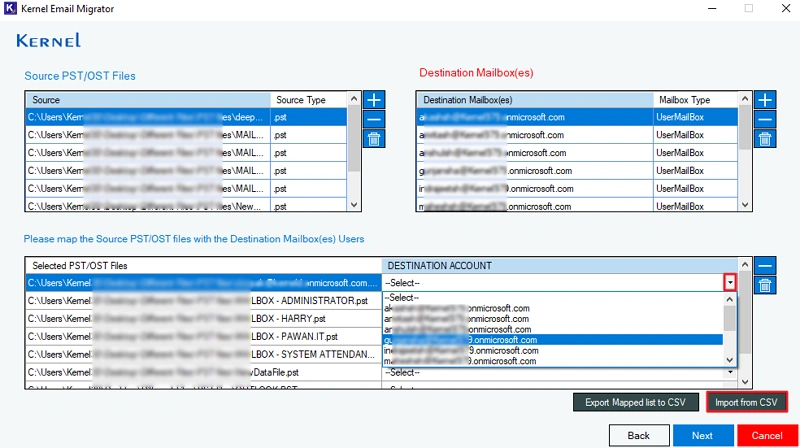
Step 9: After mapping, click Next to continue with the email migration.
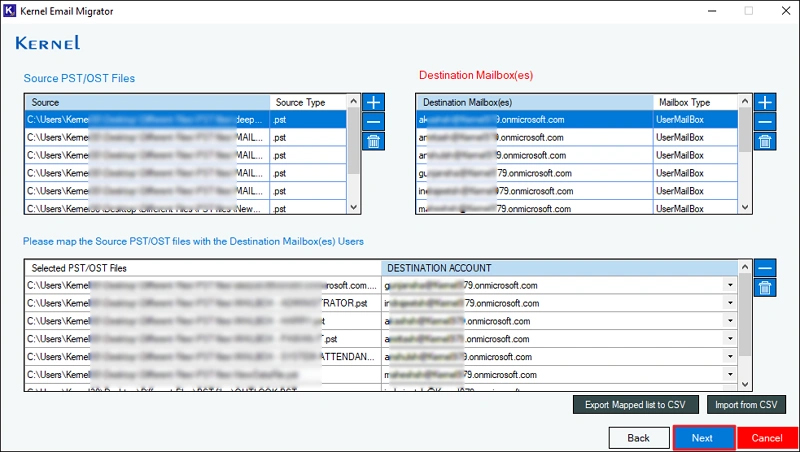
Step 10: The tool will show you all the PST files mapped with your selected mailboxes and the destination of the migration. Click Next to continue.
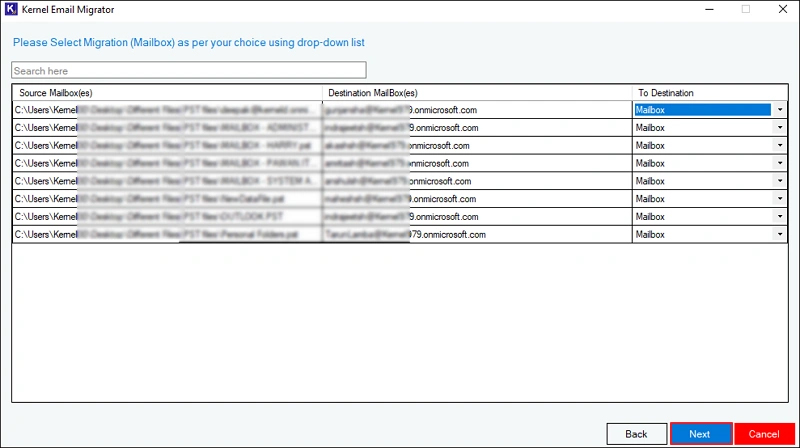
Step 11: You can exclude specific folders from the PST file for migration in the Review the PST/OST folders to migrate section. Additionally, you can apply various filters like Date Filter and Item Type Filter for selective email migration. You can exclude deleted & empty folders and transfer all emails to a specific folder. To migrate only new data, select the Incremental feature.
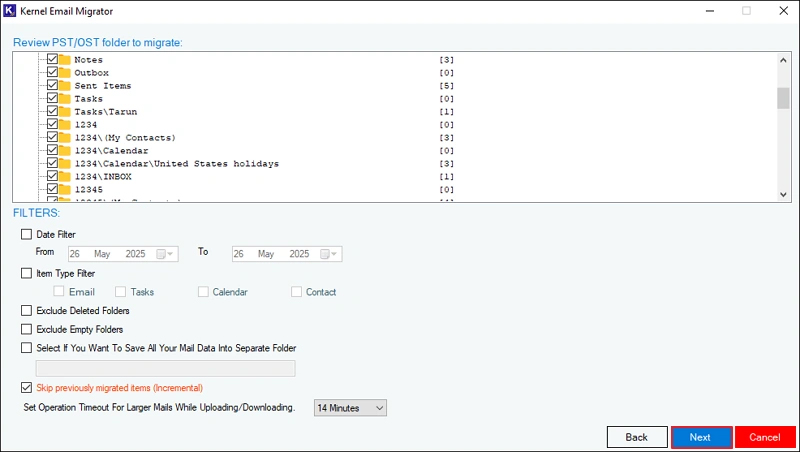
Step 12: To begin the migration instantly, select the Execute Immediate option and click Finish.

Step 13: To run the migration automatically later, select Schedule and click on Change Schedule. Then, set occurrence, date, time, frequency, and the duration of the migration. Click Finish after setting up the time.

Step 14: The job will be created and PST to Office 365 migration will start. Notice the State of the job, it will be in the Running state. You can also Pause or Stop the current job in case of any emergency.
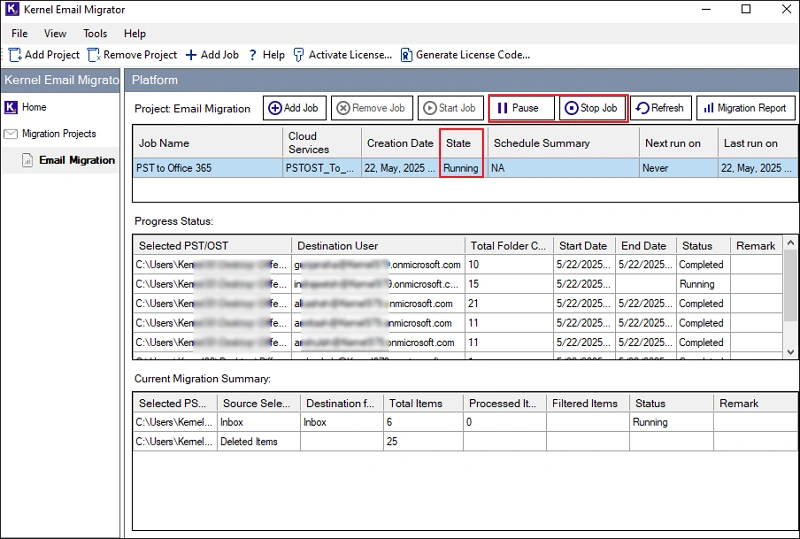
Step 15: After the migration is completed, the job state changes to Ready. To view the migration report, click on the Migration Report button.

Step 16: Select the report you want to view and click View Details.

Step 17: The tool creates a detailed report for every migration job you run. You can also download this report to your local system by clicking on the button Save Report to CSV.

OST to Office 365 Migration
Step 1. Open the Kernel Email Migrator software and click on the Outlook Mailbox Files button under the Source section.

Step 2. Select the migration type - OST to Office 365. Give project name and a job name. Then click Next. This job will be the part of the project name you have given.
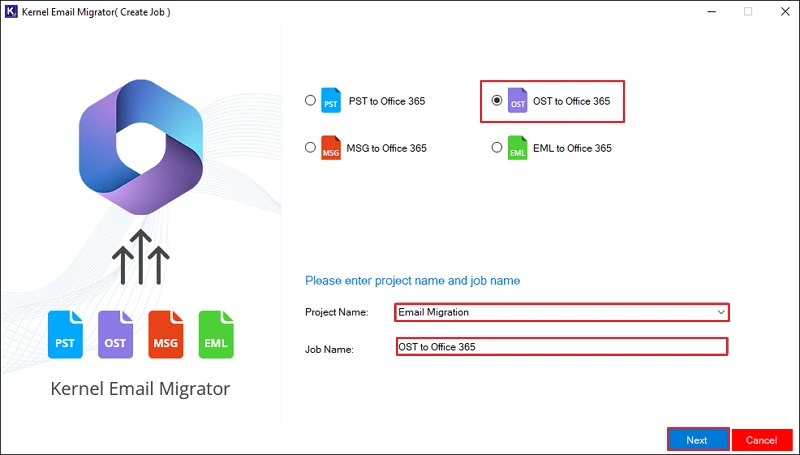
Step 3. Now, we will select the OST file(s) that you want to migrate to Office 365. Click on the Add button under the Step 1: Add Source section.
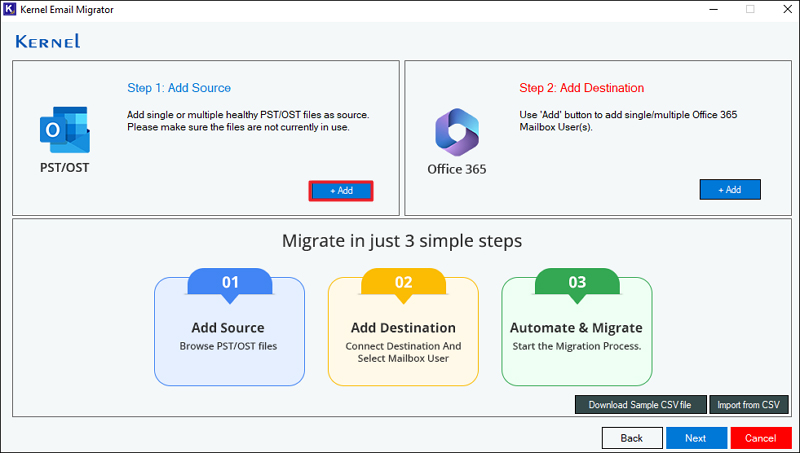
Step 4. Go to the location where the OST file(s) are available. Select single or multiple files and click Open to add these files as the source.

Step 5. After adding the source OST files, let's configure the destination Office 365 account. Click the Add button in the Step 2: Add Destination section.

Step 6. Under the Connect Destination, provide Tenant ID, Client ID, and Client Secret Value for the Microsoft 365 account you wish to add as the destination. After entering the credentials, click Connect to authenticate the values and establish a secure connection between the email migrator and the Office 365 account.

Step 7. To migrate the OST files to a single mailbox, select Single Mailbox User. However, to transfer different OST files to different mailboxes, select the List All Mailbox Using Above Credentials option and click on the Get User Mailbox button. Then, select the mailboxes from the list and click Add.

Step 8. For accurate email migration, you must map the source OST file to a destination user mailbox. In the mapping section, you will find a dropdown against every selected OST file. Use the dropdown to select the mailbox for that OST file. Alternatively, for quick mapping, click on Import from CSV button and upload a CSV file with correct mapping information. The tool will analyze the CSV file and map automatically.

Step 9. After mapping, click Next to continue with the email migration.

Step 10. The tool will show you all the OST files mapped with your selected mailboxes and the destination of the migration. Click Next to continue.

Step 11. You can exclude specific folders from the PST file for migration in the Review the PST/OST folders to migrate section. Additionally, you can apply various filters like Date Filter and Item Type Filter for selective email migration. You can exclude deleted & empty folders and transfer all emails to a specific folder. To migrate only new data, select the Incremental feature.

Step 12. To begin the migration instantly, select the Execute Immediate option and click Finish.
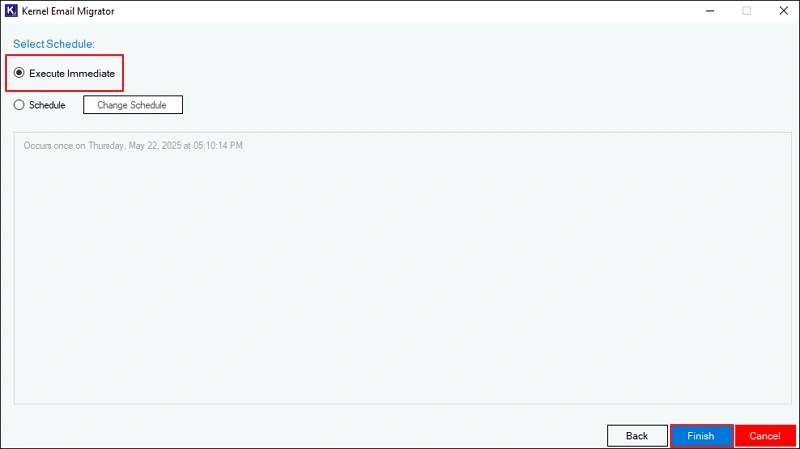
Step 13. To run the migration automatically later, select Schedule and click on Change Schedule. Then, set occurrence, date, time, frequency, and the duration of the migration. Click Finish after setting up the time.
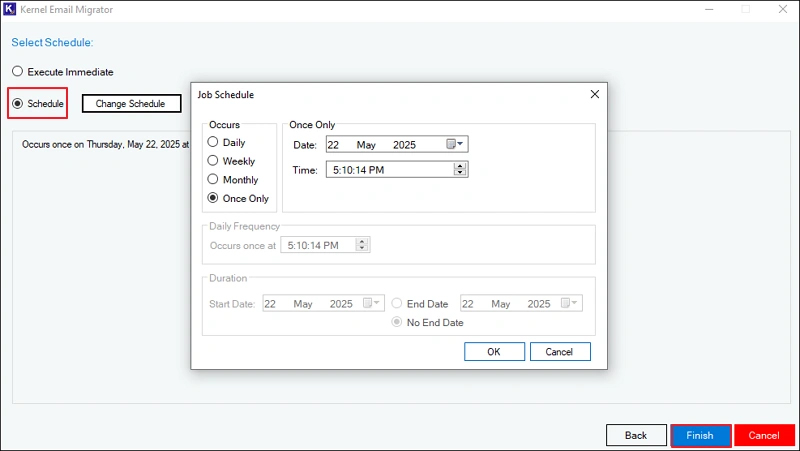
Step 14. The job will be created and OST to Office 365 migration will start. Notice the State of the job, it will be in the Running state. You can also Pause or Stop the current job in case of any emergency.

Step 15. After a successful migration, the job state changes to Ready. To view the migration report, click on the Migration Report button.
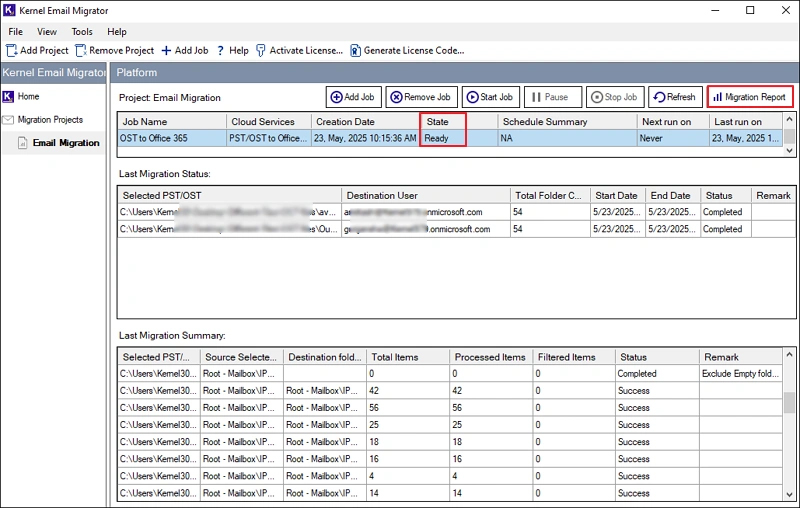
Step 16. Select the report you want to view and click View Details.

Step 17. The tool creates a detailed report for every migration job you run. You can also download this report to your local system by clicking on the button Save Report to CSV.

MSG to Office 365 Migration
Step 1. Open the Kernel Email Migrator software and click on the Outlook Message Files button under the Source section.
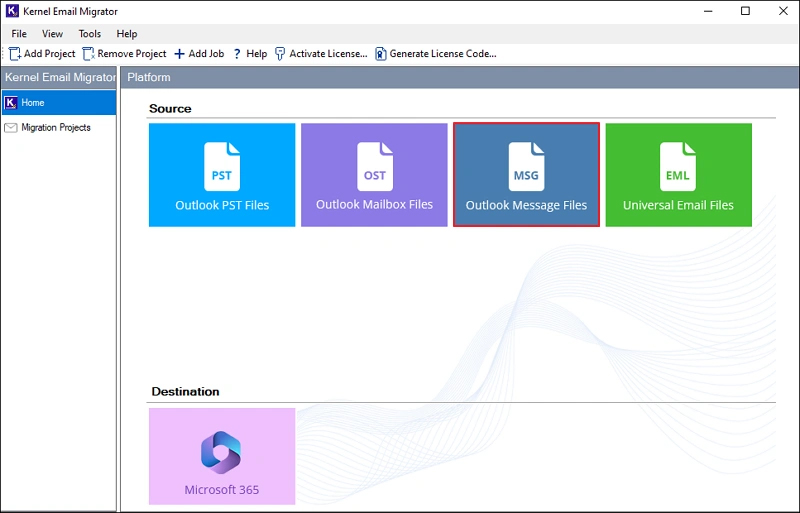
Step 2. Select the migration type as MSG to Office 365. Give project name and a job name. Then click Next. This job will be the part of the project name you have given.

Step 3. To select the complete folder containing the MSG files, select the option Choose MSG/EML Folder. Then, click Browse and go to the folder location. Select the folder and click OK. Alternatively, you can select the option Choose MSG/EML From Files and choose individual MSG files for migration.

Step 4. Click Next after folder/file selection.

Step 5. Enter Tenant ID, Client ID, and Client Secret Value to add the destination. Click Next to verify the credentials and connect to the Office 365 account.

Step 6. Select the destination mailbox in which the entire MSG files will be migrated and click Next. You can also search for a particular mailbox using User Name and User Principal Name.
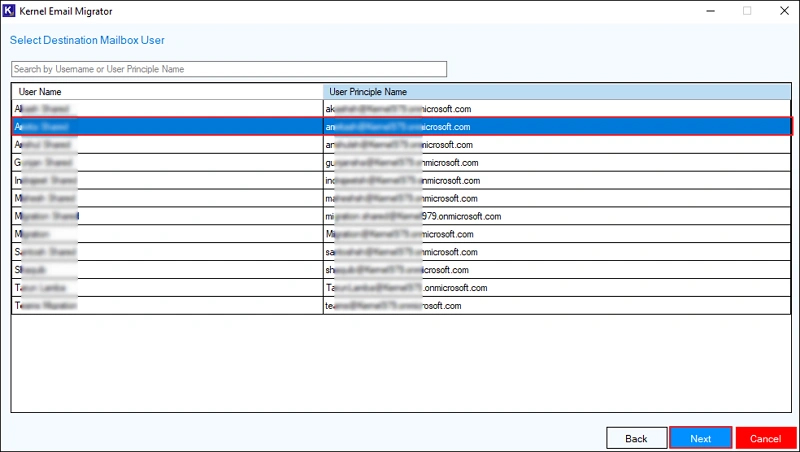
Step 7. For selective email migration, user can specify a particular date range. The tool also allows migrating the emails in a separate folder with or without original folder hierarchy. To migrate only new data and skip any previously migrated data, select the option Skip previously migrated items (Incremental). Click Next to move forward.

Step 8. To start the email migration immediately, select the Execute Immediate option and click Finish.

Step 9. To run the migration automatically later, select Schedule and click on Change Schedule. Then, set the occurrence, date, time, frequency and duration of the migration. Click Finish after setting up the time.

Step 10. The job will be created and MSG to Office 365 migration will start. Notice the State of the job, it will be in the Running state. You can also Pause or Stop the current job in case of any emergency.
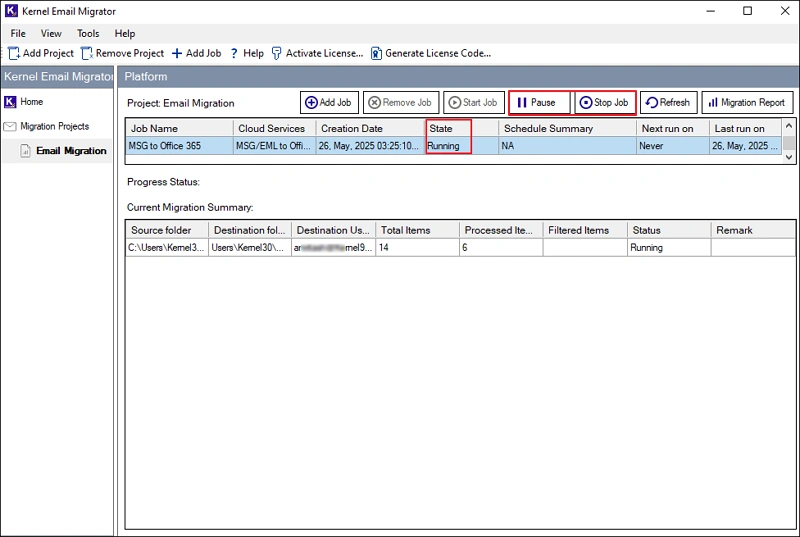
Step 11. After the migration is completed, the job state changes to Ready. To view the migration report, click on the button Migration Report.

Step 12. Select the report you want to view and click View Details.

Step 13. The tool creates a detailed report for every migration job you run. You can also download this report to your local system by clicking on the button Save Report to CSV.

EML to Office 365 Migration
Step 1. Open the Kernel Email Migrator software and click on the Universal Email Files button under the Source section.

Step 2. Select the migration type as EML to Office 365. Give project name and a job name. Then click Next. This job will be the part of the project name you have given.

Step 3. To select the folder containing the EML files, select the option Choose MSG/EML Folder. Then, click Browse and go to the folder location. Select the folder and click OK. Alternatively, you can select the option Choose MSG/EML From Files and select individual EML files for migration.

Step 4. Click Next after folder/file selection.

Step 5. Enter Tenant ID, Client ID, and Client Secret Value to add the destination. Click Next to verify the credentials and connect to the Office 365 account.

Step 6. Select the destination mailbox in which the entire EML files will be migrated and click Next. You can also search for a particular mailbox using User Name and User Principal Name.

Step 7. For selective email migration, users can specify a particular date range. The tool also allows migrating the emails in a separate folder with or without original folder hierarchy. To migrate only new data and skip any previously migrated data, select the option Skip previously migrated items (Incremental). Click Next to move forward.
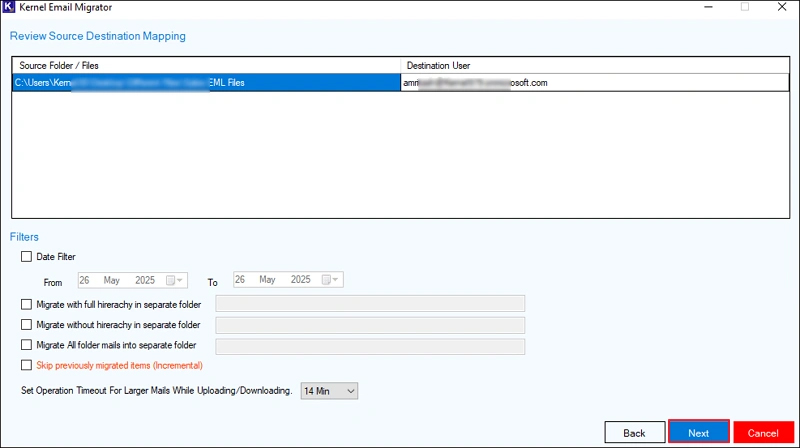
Step 8. To start email migration immediately, select the Execute Immediate option and click Finish.

Step 9. To run the migration automatically later, select Schedule and click on Change Schedule. Then, set the occurrence, date, time, frequency and duration of the migration. Click Finish after setting up the time.

Step 10. The job will be created and EML to Office 365 migration will start. Notice the State of the job, it will be in the Running state. You can also Pause or Stop the current job in case of any emergency.

Step 11. After a successful migration, the job state changes to Ready. To view the migration report, click on the button Migration Report.
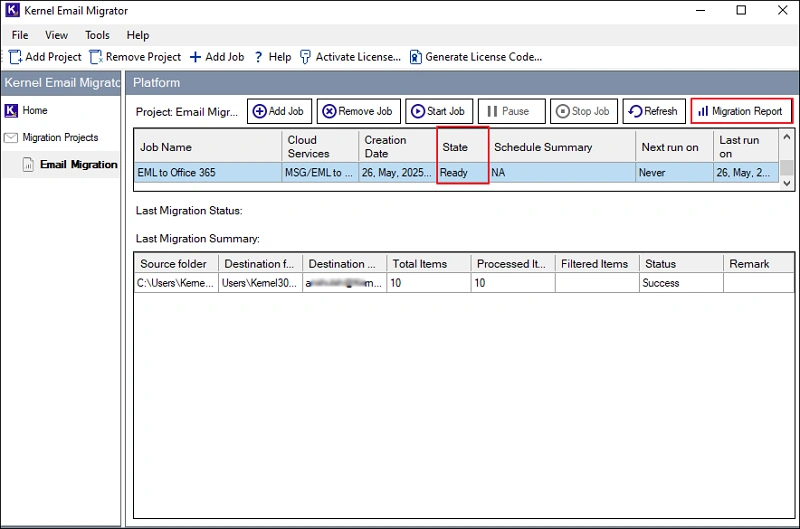
Step 12. Select the report you want to view and click View Details.

Step 13. The tool creates a detailed report for every migration job you run. You can also download this report to your local system by clicking on the button Save Report to CSV.
